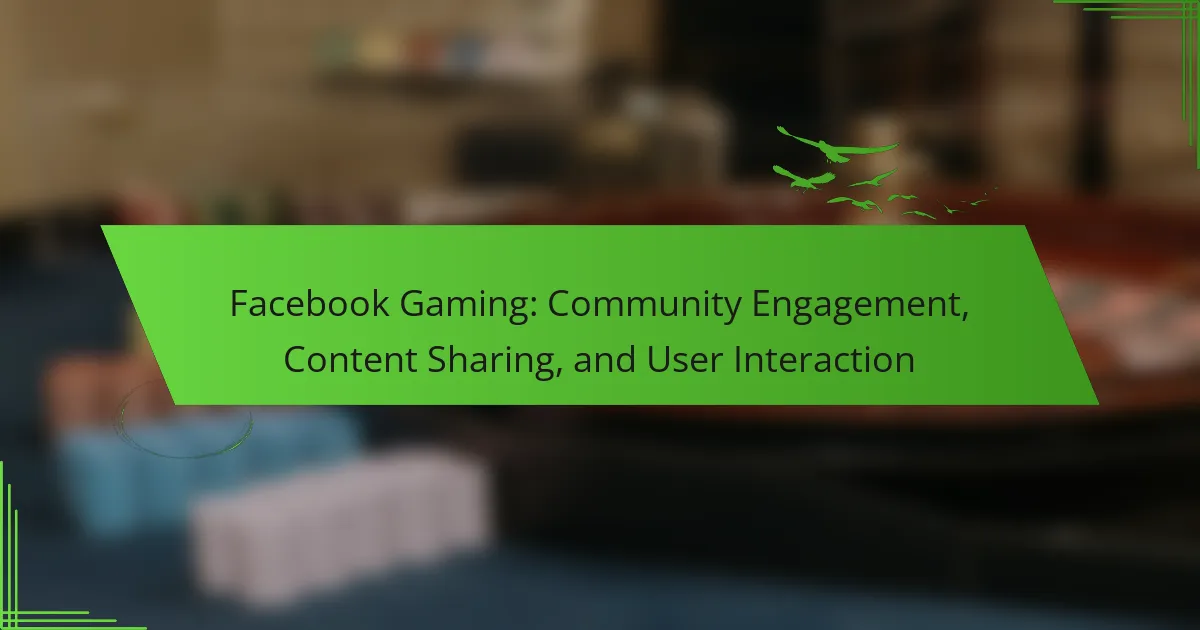Game jams offer a unique opportunity for community building and collaboration among developers, artists, and enthusiasts. This article explores effective collaboration techniques, essential event planning strategies, and the impact of cultural differences on team dynamics. It also highlights innovative game jam formats and addresses common challenges faced by organizers. By focusing on inclusivity and clear communication, game jams can enhance creativity and foster lasting connections.

What are the key objectives of game jams?
The key objectives of game jams include fostering community, enhancing collaboration, and improving event planning. These events encourage participants to work together, share ideas, and develop skills in a short timeframe. Game jams promote creativity and innovation by challenging teams to produce playable games rapidly. They also serve as networking opportunities, connecting developers, artists, and enthusiasts, which can lead to future collaborations.
How do game jams foster community engagement?
Game jams foster community engagement by bringing together diverse individuals to collaborate on creative projects. Participants share skills, ideas, and experiences, creating a sense of belonging. The collaborative environment encourages networking, leading to lasting relationships. Additionally, game jams often promote inclusivity, allowing various voices to contribute, enhancing community cohesion. These events can also lead to the development of new games that reflect the collective creativity of the group.
What skills can participants develop during game jams?
Participants can develop various skills during game jams, including teamwork, problem-solving, and time management. Collaboration techniques are emphasized, fostering communication and creativity among team members. Event planning skills are also honed, as participants organize and execute projects within tight deadlines. Additionally, technical skills in programming, design, and project management are enhanced through hands-on experience.
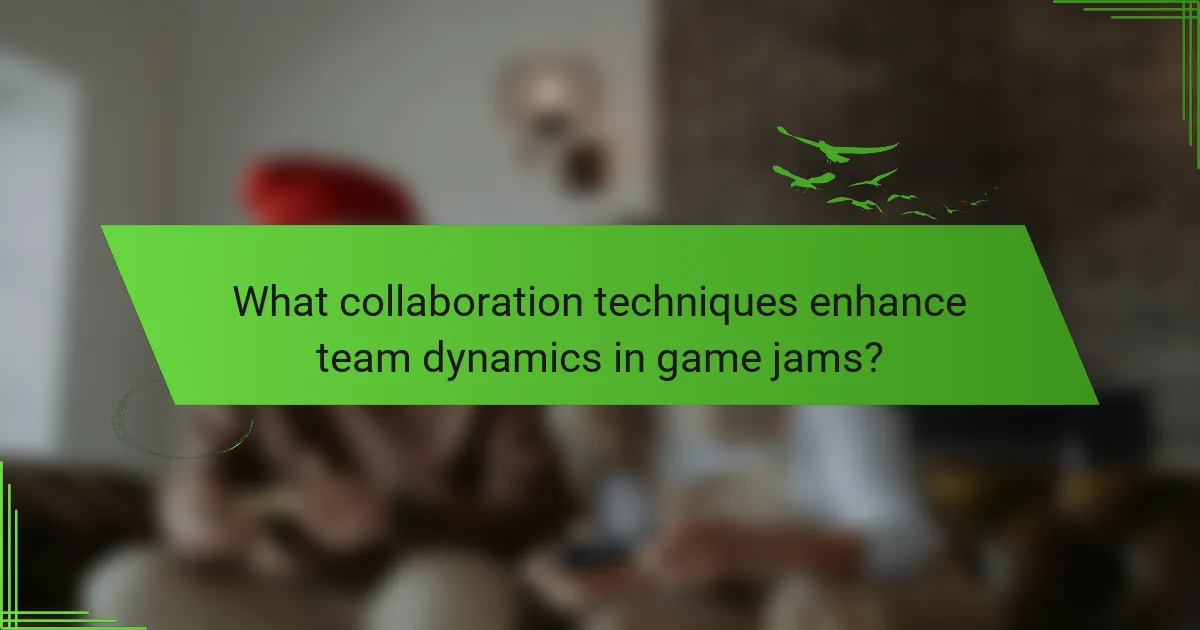
What collaboration techniques enhance team dynamics in game jams?
Collaboration techniques that enhance team dynamics in game jams include clear communication, role assignment, and iterative feedback. Establishing a shared vision fosters unity. Utilizing tools like collaborative platforms streamlines coordination. Regular check-ins maintain alignment and morale. Emphasizing flexibility allows teams to adapt to challenges effectively.
How can diverse skill sets improve game jam outcomes?
Diverse skill sets enhance game jam outcomes by fostering creativity, collaboration, and problem-solving. Teams with varied expertise can tackle challenges from multiple angles, leading to innovative solutions. This diversity encourages knowledge sharing, improving overall project quality. Additionally, it promotes a supportive environment, enhancing team dynamics and engagement.
What role does communication play in successful collaboration?
Effective communication is crucial for successful collaboration in game jams. It fosters teamwork, enhances creativity, and ensures that ideas are shared effectively. Clear communication helps prevent misunderstandings, aligning team members towards common goals. Active listening and feedback are essential components that strengthen relationships and build trust among participants. Moreover, utilizing collaborative tools can streamline communication, making it easier to share progress and solve problems in real-time. Overall, strong communication practices lead to more productive and enjoyable game jam experiences.
Which tools facilitate teamwork during game jams?
Collaboration tools that facilitate teamwork during game jams include platforms for communication, project management, and version control. Tools like Discord enable real-time communication, while Trello organizes tasks efficiently. GitHub aids in version control, ensuring smooth collaboration on code. Additionally, tools like Miro enhance brainstorming and idea mapping, fostering creativity among team members.
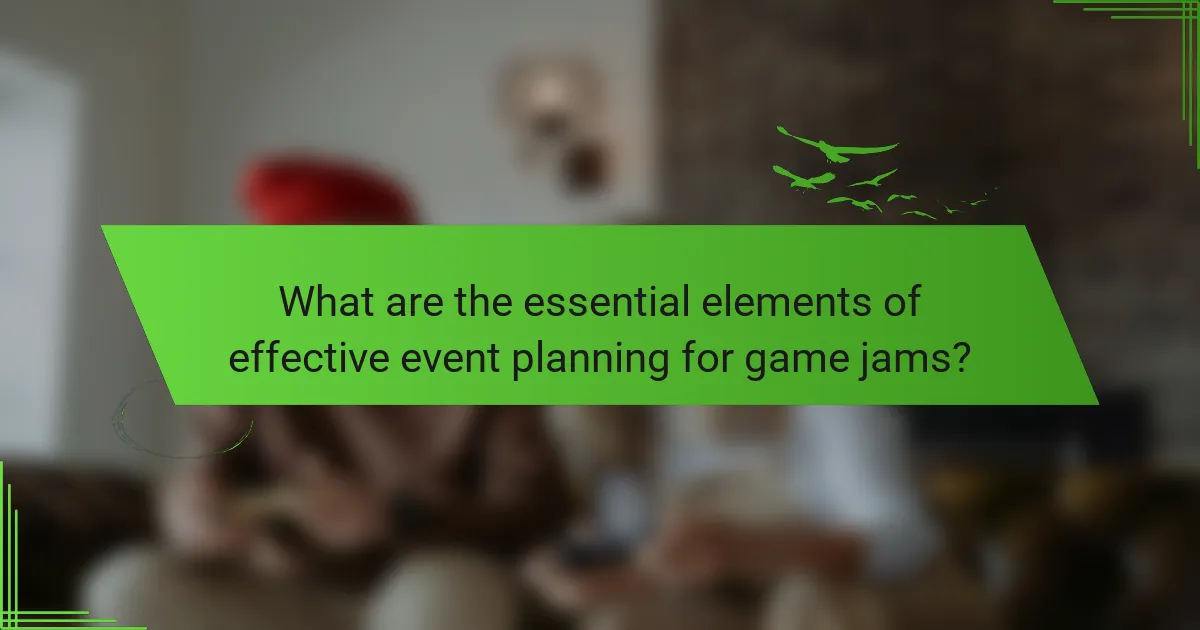
What are the essential elements of effective event planning for game jams?
Effective event planning for game jams requires clear objectives, a structured timeline, and strong community engagement. Key elements include defining the target audience, securing a suitable venue, and establishing collaboration tools. Additionally, promoting inclusivity and diversity fosters a welcoming environment. Finally, post-event feedback is crucial for future improvements.
How do venue selection and logistics impact game jam success?
Venue selection and logistics significantly influence game jam success by fostering collaboration and community engagement. A well-chosen venue enhances accessibility, comfort, and creativity. Proper logistics ensure smooth operations, including equipment availability and scheduling. These factors contribute to participant satisfaction, leading to higher quality projects and stronger community ties.
What strategies ensure participant engagement and retention?
Engaging participants and ensuring retention in game jams requires a mix of community-building strategies, collaboration techniques, and effective event planning. Fostering a welcoming environment encourages creativity and connection among participants.
Incorporating mentorship programs can enhance collaboration. Experienced mentors guide teams, improving skill development and project quality. Regular check-ins maintain motivation and address challenges, ensuring participants feel supported.
Offering incentives, such as prizes or recognition, boosts engagement. Participants are more likely to commit when they see tangible rewards for their efforts.
Creating a post-event community solidifies connections made during the jam. Online platforms allow participants to share projects, receive feedback, and continue collaborating beyond the event.
How can sponsors and partnerships enhance game jam experiences?
Sponsors and partnerships significantly enhance game jam experiences by providing resources, mentorship, and networking opportunities. They offer financial support, which can improve event logistics and participant engagement. Additionally, sponsors may provide tools or software, enriching the development process. Collaborating with industry professionals creates mentorship opportunities, guiding participants through challenges. Partnerships can also expand the reach of the event, attracting a more diverse group of participants. This diversity fosters innovation and creativity, essential elements in successful game jams.

Which unique formats of game jams are gaining popularity?
Unique formats of game jams gaining popularity include themed jams, hybrid jams, and remote jams. Themed jams focus on specific concepts or genres, fostering creativity. Hybrid jams combine physical and online participation, enhancing accessibility. Remote jams allow global collaboration, expanding community reach and diversity. Each format enhances engagement and collaboration among participants.
What are the benefits of themed game jams?
Themed game jams offer numerous benefits, including enhanced creativity, community engagement, and skill development. Participants collaborate under a shared theme, fostering teamwork and innovative thinking. These events also provide networking opportunities, connecting creators with industry professionals. Additionally, themed game jams can lead to polished prototypes that showcase participants’ talents.
How do online game jams differ from in-person events?
Online game jams focus on digital collaboration, while in-person events emphasize face-to-face interaction. Online game jams enable participants from diverse locations to join, fostering a global community. In contrast, in-person events promote stronger team dynamics through shared experiences and immediate feedback. Accessibility is a key difference; online jams often attract more participants due to lower barriers. However, in-person events can enhance networking opportunities and create lasting relationships among creators.
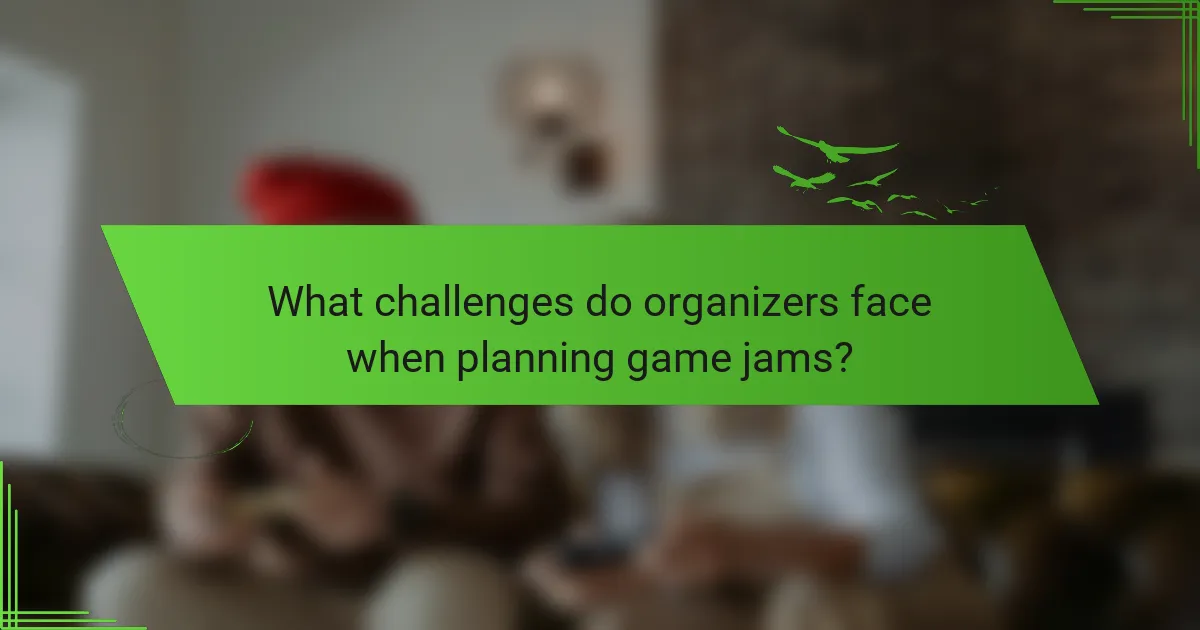
What challenges do organizers face when planning game jams?
Organizers face several challenges when planning game jams, including limited resources, time constraints, and participant engagement. Ensuring a diverse skill set among participants can also be difficult. Additionally, logistical issues such as venue selection and technology setup can impede the planning process. Communication among team members is crucial, as misunderstandings can lead to inefficiencies and frustration.
How can budget constraints affect event execution?
Budget constraints significantly impact event execution by limiting resources, affecting quality and scope. With reduced funding, organizers may face challenges in venue selection, technology access, and promotional efforts. This can lead to smaller participant numbers and less community engagement. Additionally, collaboration techniques may suffer, as fewer resources can restrict team dynamics and creative expression. Ultimately, effective planning and prioritization become essential to maximize impact within financial limits.
What are common pitfalls to avoid when organizing a game jam?
To avoid common pitfalls when organizing a game jam, focus on clear communication, defined roles, and adequate resources. Misalignment in team goals can hinder collaboration, so establish a shared vision early. Lack of time management leads to rushed submissions, so set realistic deadlines. Ensure participants have access to necessary tools and support to foster creativity. Lastly, neglecting post-event feedback can prevent improvement for future jams, so prioritize gathering insights from participants.
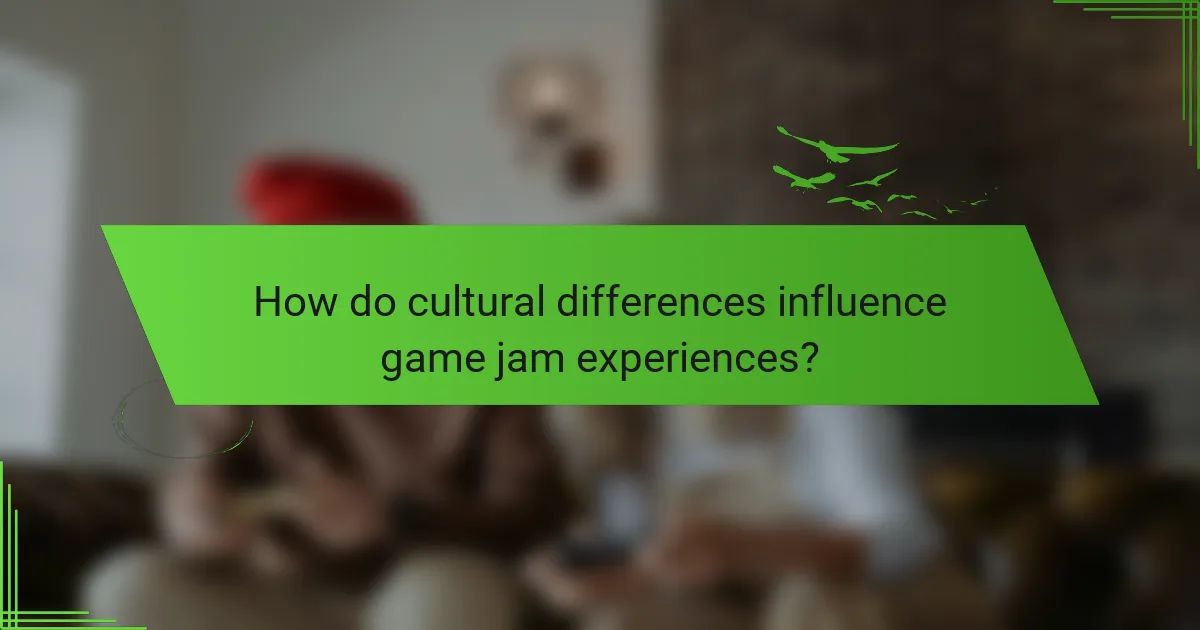
How do cultural differences influence game jam experiences?
Cultural differences significantly shape game jam experiences by influencing collaboration styles and community dynamics. Participants from diverse backgrounds bring unique perspectives, fostering creativity and innovation. For instance, cultural norms affect communication, decision-making, and conflict resolution approaches. As a result, understanding these differences enhances teamwork and project outcomes. Additionally, varying levels of familiarity with game development processes can lead to a mix of skillsets, enriching the overall experience. Emphasizing inclusivity and cultural awareness can further improve engagement and collaboration during these events.
What role do local gaming communities play in shaping game jams?
Local gaming communities play a crucial role in shaping game jams by fostering collaboration and creativity among participants. These communities provide a supportive environment that encourages skill sharing and networking. They often organize events, recruit participants, and offer resources, which enhances the overall experience. Additionally, local communities can influence the themes and objectives of game jams, making them more relevant to regional interests. This localized engagement helps to build lasting relationships among developers, leading to future collaborations and projects.
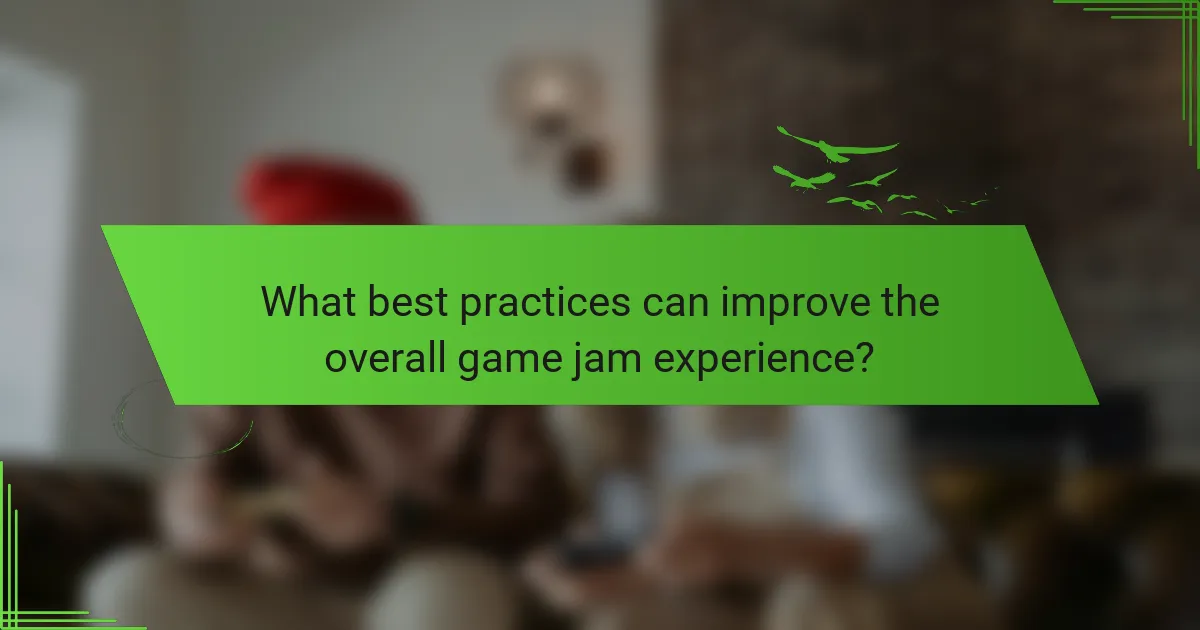
What best practices can improve the overall game jam experience?
To improve the overall game jam experience, focus on clear communication, structured teamwork, and inclusive environments. Encourage regular check-ins to monitor progress and foster collaboration. Organize workshops and mentorship sessions to enhance skills and creativity. Provide ample resources and support to ensure participants feel valued and engaged.
How can feedback be effectively gathered and utilized post-event?
To effectively gather and utilize feedback post-event, implement surveys and focus groups. Surveys can quantify participant satisfaction and identify areas for improvement. Focus groups allow for in-depth discussions, revealing insights that surveys may miss. Analyze the feedback to inform future game jams, enhancing community engagement and collaboration techniques. Prioritize actionable items to create a more impactful event experience.
What strategies can enhance networking opportunities for participants?
To enhance networking opportunities for participants in game jams, focus on structured collaboration, diverse team formations, and interactive activities. Encourage participants to engage in icebreaker sessions to foster connections.
Organize workshops that emphasize skill-sharing, allowing individuals to showcase their expertise. Create breakout sessions for specific interests, promoting deeper discussions. Utilize social media platforms to facilitate ongoing communication before, during, and after the event.
Lastly, implement feedback mechanisms for participants to share experiences and suggestions, which can strengthen future networking efforts.
What common mistakes should organizers avoid in future game jams?
Organizers should avoid poor communication, inadequate planning, and unrealistic expectations in future game jams. Clear guidelines and timelines enhance collaboration and community engagement.
1. Lack of clear communication can lead to confusion about roles and objectives.
2. Inadequate planning may result in logistical issues and resource shortages.
3. Setting unrealistic expectations can demotivate participants and hinder creativity.
4. Failing to provide adequate feedback can stifle growth and improvement.
5. Ignoring participant diversity can limit perspectives and innovation.
6. Neglecting post-event follow-up can weaken community bonds and future participation.

